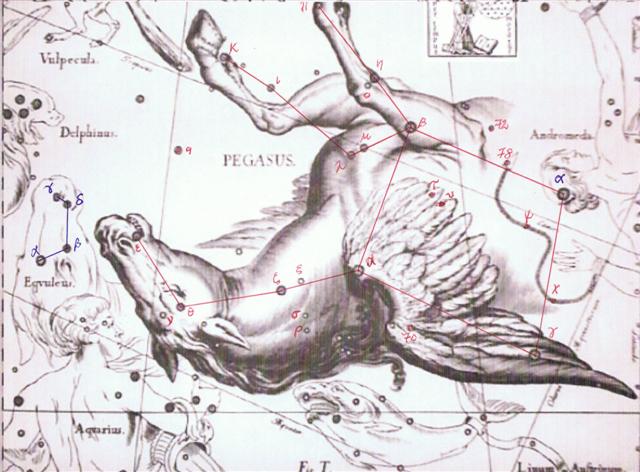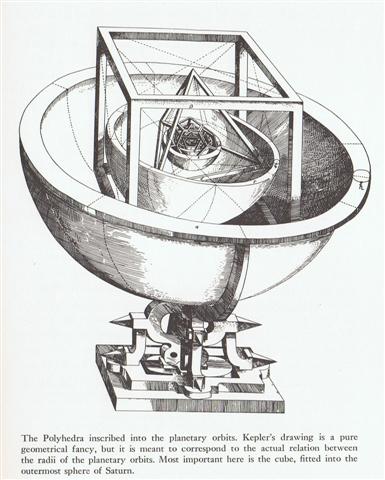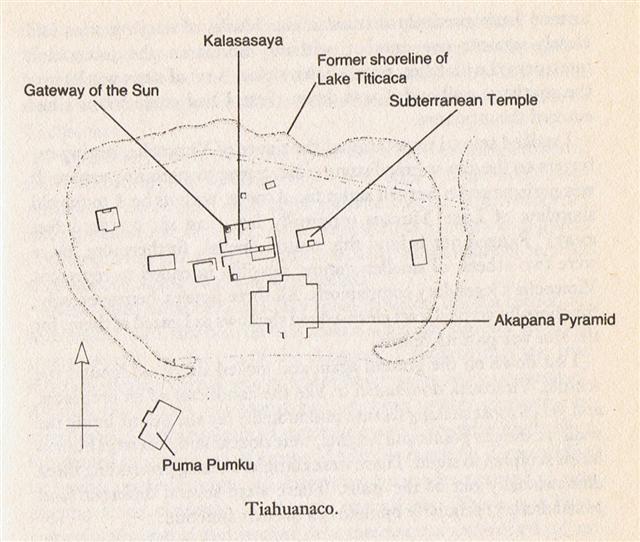Having thus secured - at least provisionally - that heliacal time flows uninterrupted past the Mouth of the Fish and Gb2-28 for at least 55 days (at least to hipu in Gb4-17) we can now move on to line Gb3. However, there are 35 glyphs in line Gb2, and the last 7 of them should also be presented:
Between Gb2-29 (as in the number of glyphs on side a of the tablet) and Gb2-30 was, at the time of the Hyades Gate, the border between the old year and the new year - assuming the new year was beginning in December 31. This is probably how we should read the glyphs. Possibly the gods were homeless previous to this date, because the Chinese 13th station was House, ruled by Markab (α Pegasi):
The Fore Spout (Al Fargh al Mukdim) was ruled also by Scheat (β) and the Rear Spout (Al Fargh al Thāni) was ruled by γ (Algenib) and Sirrah (α Andromedae). ... two diviners and their wives sit on benches so that they occupy the corner positions of the cosmic square ...
Together these 'spouts' may have resulted in the indundated Field of the Babylonians, where the Great One is holding a pair of spouts standing above the Fish, which resembles how Aquarius is in the center of time above Piscis Austrinus:
... Aquarius is identified as GU.LA 'The Great One' in the Babylonian star catalogues and represents the god Ea himself, who is commonly depicted holding an overflowing vase. The Babylonian star-figure appears on entitlement stones and cylinder seals from the second millennium. It contained the winter solstice in the Early Bronze Age. In Old Babylonian astronomy, Ea was the ruler of the southernmost quarter of the Sun's path, the 'Way of Ea', corresponding to the period of 45 days on either side of winter solstice. In the Greek tradition, the constellation became represented as simply a single vase from which a stream poured down to Piscis Austrinus. The name in the Hindu zodiac is likewise kumbha 'water-pitcher' ... The Hindus may have imagined the Pegasus Square as a funeral cot for the old year:
Kerb (τ Pegasi) - at the feathered right wing of Pegasus - could have meant a new hipu was here (anciently in January 4) uplifted from the deeps. ... τ, 4.5, with ν, was Al Sufi's Sa'd al Na'amah, which Knobel thinks should be Al Na'āim, the Cross-bars over a well; but they also were known as Al Karab, the Bucket-rope. The usual titles for τ - Markab and Sagma or Salma - are from Bayer, but the last two should be Salm, a Leathern Bucket ... In winter and in high positions the rains turn to snow, and NGC 7662 Andromedae received the name Snowball Nebula:
355 days after 0h (at the time of rongorongo) resembled the pattern of 355 days from January 1, i.e. March 11 resembled the day of the December solstice. At the time of Bharani this cold nebula rose with the Sun 314 days after 0h. Takaure in Gb3-1 was at the beginning of a new cycle.
I suddenly realize the Sun had to be uplifted not only from the ground level but from the world below, from the region south of the equator. Furthermore, there could in spring have been a change from the cube of Saturn to an octahedron - the quincunx could have its 5th stone at the top of the pyramid brought up from the opposite corner of a double pyramid (from the sacred spring).
Kepler arranged in his model the cube inside the orbit of old Saturn and the octahedron outside the orbit of young Mercury:
... Another year passed, and a man by the name of Ure Honu went to work in his banana plantation. He went and came to the last part, to the 'head' (i.e., the upper part of the banana plantation), to the end of the banana plantation. The sun was standing just right for Ure Honu to clean out the weeds from the banana plantation. On the first day he hoed the weeds. That went on all day, and then evening came. Suddenly a rat came from the middle of the banana plantation. Ure Honu saw it and ran after it. But it disappeared and he could not catch it. On the second day of hoeing, the same thing happened with the rat. It ran away, and he could not catch it. On the third day, he reached the 'head' of the bananas and finished the work in the plantation. Again the rat ran away, and Ure Honu followed it. It ran and slipped into the hole of a stone. He poked after it, lifted up the stone, and saw that the skull was (in the hole) of the stone. (The rat was) a spirit of the skull (he kuhane o te puoko). Ure Honu was amazed and said, 'How beautiful you are! In the head of the new bananas is a skull, painted with yellow root and with a strip of barkcloth around it.' Ure Honu stayed for a while, (then) he went away and covered the roof of his house in Vai Matā. It was a new house. He took the very large skull, which he had found at the head of the banana plantation, and hung it up in the new house. He tied it up in the framework of the roof (hahanga) and left it hanging there ...
"... In China, with Capricornus, Pisces, and a part of Sagittarius, it [Aquarius] constituted the early Serpent, or Turtle, Tien Yuen; and later was known as Hiuen Ying, the Dark Warrior and Hero, or Darkly Flourishing One, the Hiuen Wu, or Hiuen Heaou, of the Han dynasty, which Dupuis gave as Hiven Mao. It was a symbol of the emperor Tchoun Hin, in whose reign was a great deluge; but after the Jesuits came in it became Paou Ping, the Precious Vase. It contained three of the sieu, and headed the list of zodiac signs as the Rat, which in the far East was the ideograph for 'water', and still so remains in the almanacs of Central Asia, Cochin China, and Japan." (Allen)
... I walked towards it now, and spent some time strolling around it and clambering over it. Originally it had been a clean-sided step-pyramid of earth faced with large andesite blocks. In the centuries since the conquest, however, it had been used as a quarry by builders from as far away as La Paz, with the result that only about ten per cent of its superb facing blocks now remained. What clues, what evidence, had those nameless thieves carried off with them? As I climbed up the broken sides and around the deep grassy troughs in the top of the Akapana, I realized that the true function of the pyramid was probably never going to be understood. All that was certain was that it had not been merely decorative or ceremonial. On the contrary, it seemed almost as though it might have functioned as some kind of arcane 'device' or machine. Deep within its bowels, archaeologists had discovered a complex network of zigzagging stone channels, lined with fine ashlars. These had been meticulously angled and jointed (to a tolerance of one-fiftieth of an inch), and had served to sluice water down from a large reservoir at the top of the structure, through a series of descending levels, to a moat that encircled the entire site, washing against the pyramid's base on its southern side ...
... His temple-palace was composed of four radiant apartments: one toward the east, yellow with gold; one towards the west, blue with turquoise and jade; one toward the south, white with pearls and shells; one towards the north, red with bloodstones - symbolizing the cardinal quarters of the world over which the light of the sun holds sway. And it was set wonderfully above a mighty river that passed through the midst of the city of Tula; so that every night, precisely at midnight, the king descended into the river to bathe; and the place of his bath was called 'In the Painted Vase', or 'In the Precious Waters' ... |
|||||||||||||||||||||||||||||||||||||||||||||||||||||||||||||||||||||||||||||||||||||||||||||||||||||||||||||||||||||||||||||||||||||||||||||||||||||||||||||||||||||||||||||||||||||||||||||












